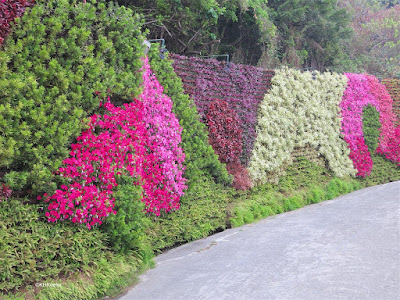 |
| Plant wall, outdoors, Mexico City |
Sometimes it works, but I see it generally as plant abuse.
 |
| plant wall, indoors, Colorado Note the gaps |
But the vast majority of plants, coleus or jade plants or roses, have strong tropisms (hormone-driven responses) that direct them to grow their roots toward the ground and shoots going up. If you turn a flowerpot onto its side, the change in the direction of gravity results in the production of hormones that direct the roots to turn downward, the shoots to go up. (more: link) If the pot is left on its side, righting itself--which is the plant's point of view--leaves the plant's roots growing in a very limited space (the lower half of the pot).
The instructions online for green walls often say tip the pots at 30 degrees. That will work to display the plants and yet leave the plants close to upright. Balancing flowerpots or window boxes on a vertical wall so that the foliage covers the wall is not easy. It has to be built well to be stable, accessible for maintenance and attractive.
 |
| The flowerpots of a green wall |
Plants take up most of their water through their roots. Sitting normally in a pot, water runs down through the pot, to be captured by the roots. In a tilted pot, the water still runs vertically down. Good watering is more difficult the more the pot is tilted.
 |
| Pots in a plant wall. The pots onthe top are not doing so well. Indoors, Colorado |
 |
| Healthy plant wall, outdoors, Taiwan |
So you get effects like the one below. The leaves are reddish and some plants have grown quite far out from the wall, but they are not doing well. (The living plants are inch plants, Tradescantia zebrina link or a similar species, spiderwort family, Commelinaceae)
 |
| Not doing well, but they're not all dead yet. Outside, Taiwan |
 |
| Dead plant wall, outside, Taiwan |
And yet,
I have seen some spectacular green walls. For example:
 |
| Along a driveway, Taiwan |
Climate is probably important for success. In humid areas, the plants will generally do better because they will get water from the air or at least will not lose water to the air very fast. And if nature waters the plants frequently, it is less important if humans do not do it well.
Finally, the display is not "set and forget." Of course they need water. But furthermore, individual plants will die or grow too big and need to be replaced.
When walls of plants work, they can be spectacular. My photo is too distant to show it well, but small-leaved plants form the green background, with ferns and vines for the focal points.
 |
| Ferns as bouquets, plants with tiny and small leaves as the green background. Outdoors, second story wall, Mexico City |
Comments and corrections welcome.
Kathy Keeler, A Wandering Botanist
More at awanderingbotanist.com
No comments:
Post a Comment